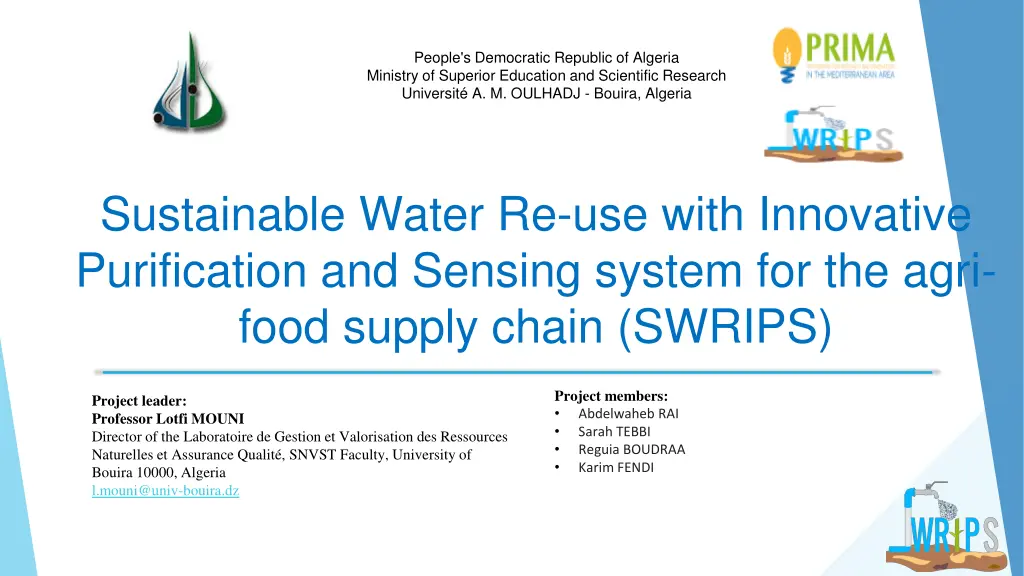
Innovative Sustainable Water Re-use Project with Advanced Purification System
Explore the Sustainable Water Re-use with Innovative Purification and Sensing system (SWRIPS) project by People’s Democratic Republic of Algeria Ministry of Superior Education and Scientific Research. The project involves developing advanced filters for bacterial and heavy metal removal, as well as creating environmental-compliant adsorption filters. Follow their research activities, including the implication of WP1 in various tasks for water, soil, and agrifood products characterization. Discover how the project aims to remove pesticides from wastewater through a synergistic photo-catalysis and adsorption process, enhancing water treatment and environmental protection.
Download Presentation

Please find below an Image/Link to download the presentation.
The content on the website is provided AS IS for your information and personal use only. It may not be sold, licensed, or shared on other websites without obtaining consent from the author. If you encounter any issues during the download, it is possible that the publisher has removed the file from their server.
You are allowed to download the files provided on this website for personal or commercial use, subject to the condition that they are used lawfully. All files are the property of their respective owners.
The content on the website is provided AS IS for your information and personal use only. It may not be sold, licensed, or shared on other websites without obtaining consent from the author.
E N D
Presentation Transcript
People's Democratic Republic of Algeria Ministry of Superior Education and Scientific Research Universit A. M. OULHADJ - Bouira, Algeria Sustainable Water Re-use with Innovative Purification and Sensing system for the agri- food supply chain (SWRIPS) Project members: Abdelwaheb RAI Sarah TEBBI Reguia BOUDRAA Karim FENDI Project leader: Professor Lotfi MOUNI Director of the Laboratoire de Gestion et Valorisation des Ressources Naturelles et Assurance Qualit , SNVST Faculty, University of Bouira 10000, Algeria l.mouni@univ-bouira.dz
Plan Research activities of WP1 Implication of WP1 in TASKS 2.2. Innovative second-stage filters based on nanocomposites for bacterial and heavy metal removal AND 2.4. Environmental-compliant adsorption filter based on Fe doped-TiO2 and zeolite Protocol Photo-catalytic test Implication of WP1 in TASKS 1.1. Characterization of water, soil, agrifood. products
Research activities of WP1 (U-Bouira) Between the start of January and the 10th of February, numerous project- related meetings (15-01-2024, 31-01-2024) were held to assign tasks to each expert. Biologists and chemists discussed about the potential for creating systems that could purify soil, water, and fruit. 1
Implication of WP1 in TASKS 2.2. AND 2.4. Our plan is to create a new filter that combines photo-catalysis and adsorption to remove pesticides from wastewater. This will allow for a synergistic effect in water decontamination. This coupling will be done in both single and separate reactors to evaluate and select the best procedure for getting rid of these stubborn molecules. 2
Environmental-compliant adsorption filter based on Fe doped-TiO2 and zeolite Optical and structural characterization. Application in light photocatalysis Adsorption enhancement by doping, or heterojunction Real water treatment 3
Environmental-compliant adsorption filter based on Fe doped-TiO2 and zeolite Preliminary tests for the creation of a treated filter for photo-catalysis were conducted over the last few weeks. Consequently, creating a degradation system with a semi-conductor and photons, a light source. Initially, the Mfe2O4type structures' photocatalytic and optical characteristics. Wherever M is located, Ni, Cu, Co, Zn, etc. 4
Environmental-compliant adsorption filter based on Fe doped-TiO2 and zeolite I. PROTOCOL Cotton samples were typically soaked in a solution of 5 mmol zinc nitrate and 10 mmol ferric nitrate in a small amount of distilled water after being dried at 70 C for 4 hours to remove adsorbed water. The mixture was given the right amount of 6M NaOH to bring the pH level down to 13. 5
Environmental-compliant adsorption filter based on Fe doped-TiO2 and zeolite After 30 minutes of magnetic stirring at 30 C, the mixture was placed in an autoclave. After that, the sealed autoclave was kept for 12 hours at 150 C. After that, the autoclave was allowed to cool to room temperature. Finally, the precipitate was filtered and washed with demineralized water. Several times to reduce the possibility of impurities in the product. The resulting product was dried in a vacuum oven at 75 C for 6 hours to obtain a ZnFe2O4 structure. 6
Environmental-compliant adsorption filter based on Fe doped-TiO2 and zeolite II. Photocatalytic test The degradation of crystal violet, which had previously been impregnated on the surface of cotton fabrics, was used to analyze the photocatalytic properties of ZnFe2O4-functionalized cotton samples. A solution (CV) was used to impregnate the cotton samples. Next, the fabrics were placed under a 20 W UV light source. 7
Environmental-compliant adsorption filter based on Fe doped-TiO2 and zeolite II. Photocatalytic test Using UV-Vis spectroscopy, the maximum absorbance value (C0) was ascertained. The C/C0 values, where C0 and C represent, respectively, the initial concentration of CV on the impregnated cotton pieces and the concentration of CV at time, were used to calculate and compare the rate of dye decomposition. 8
Implication of WP1 in Task.1.1 Characterization of water/soil/agri-food products For the purpose of the project, extensive talks and meetings were held at ENSA. In summary, the following actions were taken: The quantity of samples, the technique of sampling (such as avoiding pulling directly the fruit), and the frequency of harvesting were established according to some standards protocols. The tomato sample was selected to be tested using treated wastewater obtained from famous oil and juice industries in Algeria. 9
Implication of WP1 in Task.1.1 Characterization of water/soil/agri-food products The oil and juice industries were selected to receive their waste water for treatment. experts from ENSA have selected the appropriate protocols after intensive researches. An expert in economy will conducted the economic evaluation part. The issue of sample conservation for sending it abroad was raised. 10
